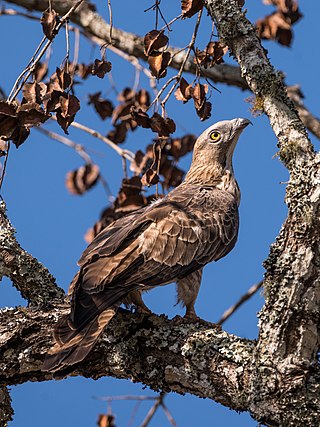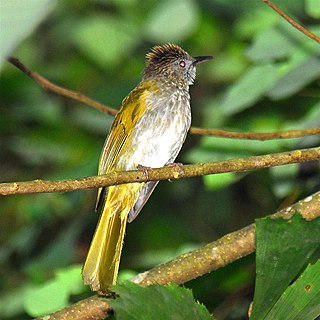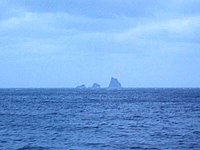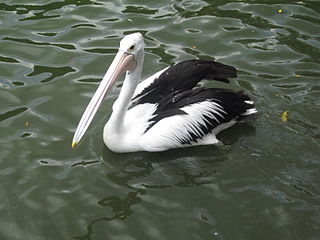
The Russian Far East is a region in North Asia. It is the easternmost part of Russia and the Asian continent, and is coextensive with the Far Eastern Federal District, which encompasses the area between Lake Baikal and the Pacific Ocean. The area's largest city is Khabarovsk, followed by Vladivostok. The region shares land borders with the countries of Mongolia, China, and North Korea to its south, as well as maritime boundaries with Japan to its southeast, and with the United States along the Bering Strait to its northeast.

The ancient murrelet is a bird in the auk family. The English term "murrelet" is a diminutive of "murre", a word of uncertain origins, but which may imitate the call of the common guillemot. Ancient murrelets are called "ancient" because they have grey on the back like a shawl, as worn by the elderly.

The crested honey buzzard is a bird of prey in the family Accipitridae, which also includes many other diurnal raptors such as kites, eagles, and harriers. Pernis ptilorhynchus has six subspecies. As a medium-sized raptor, their size ranges between 57–60 cm (22–24 in). They are also known as the Oriental, Asiatic, or Eastern honey buzzard. The name is derived from its diet, which consists mainly of the larvae of bees and wasps extracted from honey combs.

The russet sparrow, also called the cinnamon or cinnamon tree sparrow, is a passerine bird of the sparrow family Passeridae. A chunky little seed-eating bird with a thick bill, it has a body length of 14 to 15 cm (5.5–5.9 in). Its plumage is mainly warm rufous above and grey below. It exhibits sexual dimorphism, with the plumage of both sexes patterned similarly to that of the corresponding sex of house sparrow. Its vocalisations are sweet and musical chirps, which when strung together form a song.

The crested ibis, also known as the Japanese crested ibis, Asian crested ibis or toki, is a large, white-plumaged ibis of pine forests, native to eastern Asia. Its head is partially bare, showing red skin, and it has a dense crest of white plumes on the nape. It is the only member of the genus Nipponia.

Delalande's coua, also known as the snail-eating coua or Delalande's coucal, is an extinct species of non-parasitic cuckoo from Madagascar. It was only known to science as an extant bird for a very short time in the early 19th century. There is some disagreement about its area of occurrence: Although there were claims that the bird was also found in the area of Fito and Maroantsetra as well as near Toamasina (Tamatave), i.e., the coastal areas of northern Toamasina Province, all specimens with good locality data are from the offshore island of Nosy Boraha. As the vernacular name implies, land snails were a favored food item of this species.

The crested kingfisher is a very large kingfisher that is native to parts of southern Asia. It is part of the kingfisher genus (Megaceryle) with three other species: the giant kingfisher, the ringed kingfisher, and the belted kingfisher with which it forms a species complex.

The Japanese pygmy woodpecker or pygmy woodpecker is a species of woodpecker. It is found in coniferous and deciduous forests in Russia, China, Korea and Japan. This species has also been placed in the genus Dendrocopos or Picoides. The International Union for Conservation of Nature (IUCN) has assessed it as a least-concern species.

The Japanese night heron is a species of night heron found in East Asia. It breeds in Japan, and winters in the Philippines and Indonesia. It is also seen in the spring and summer in Korea and the Russian Far East.

Ijima's leaf warbler is a species of Old World warbler in the family Phylloscopidae. The species is native to Japan, where it has been designated a Natural Monument under the 1950 Law for the Protection of Cultural Properties, with records also from Taiwan and the Philippines.

Ixos is a genus of passerine birds in the bulbul family, Pycnonotidae.

The Javan blue-banded kingfisher, is a species of kingfisher in the subfamily Alcedininae. It is endemic to and found throughout Java, but is thought to be extremely rare due to human pressures such as habitat destruction. Its natural habitats are subtropical or tropical moist lowland forest, subtropical or tropical mangrove forest, and rivers. Its population is estimated to be just 50-249 individuals, and is believed to be in decline.

The golden-whiskered barbet is an Asian barbet species native to the western Malay Archipelago, where it inhabits foremost forests up to 1,500 m (4,900 ft) elevation. It has been listed as Least Concern on the IUCN Red List since 2004 because of its wide distribution.


















